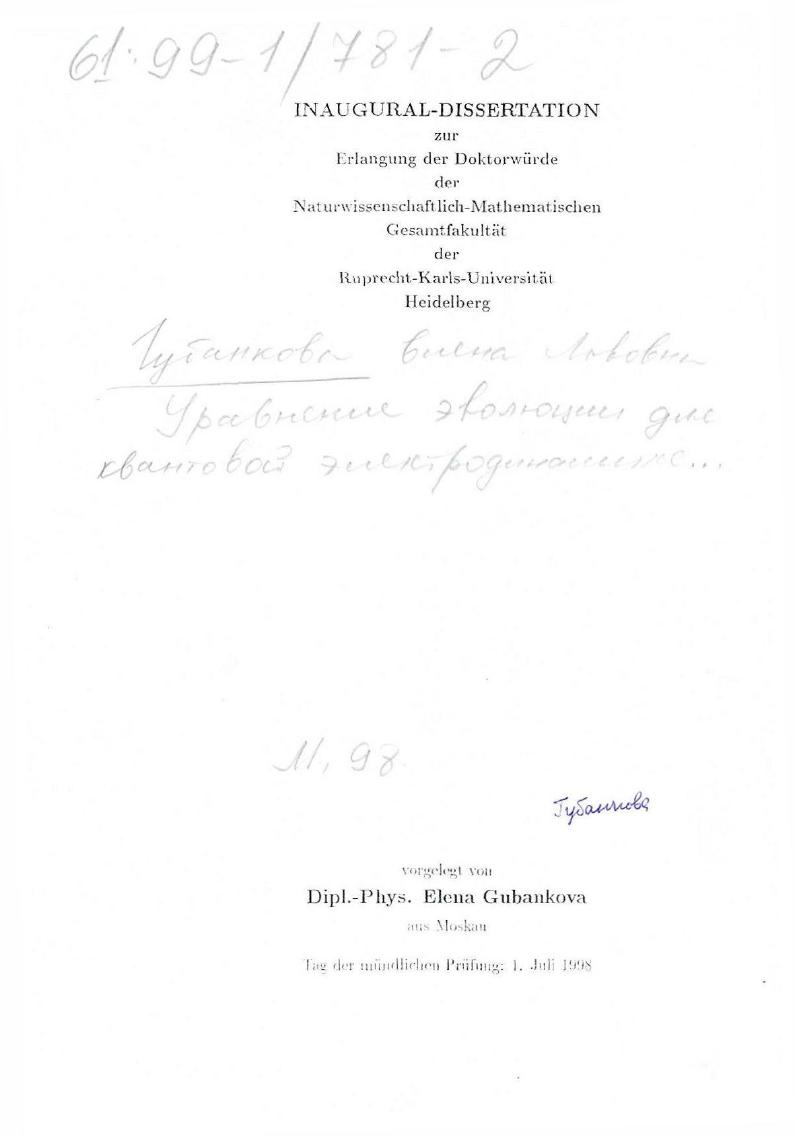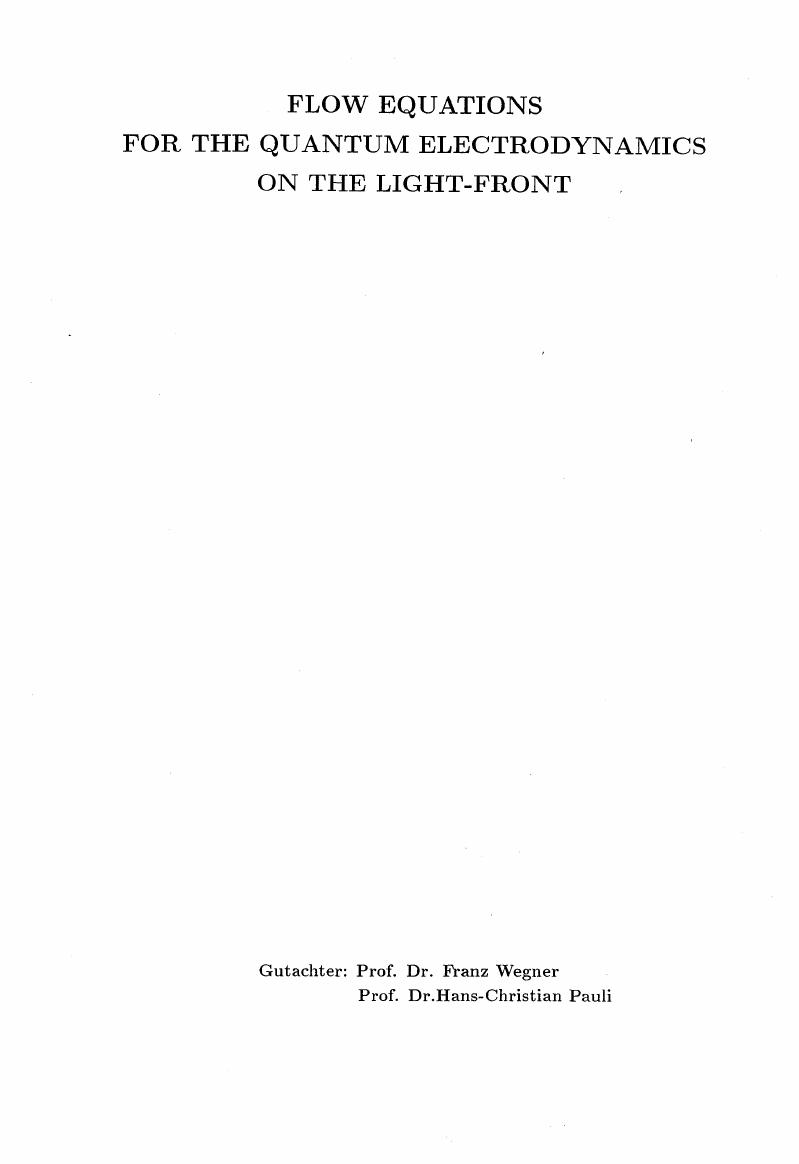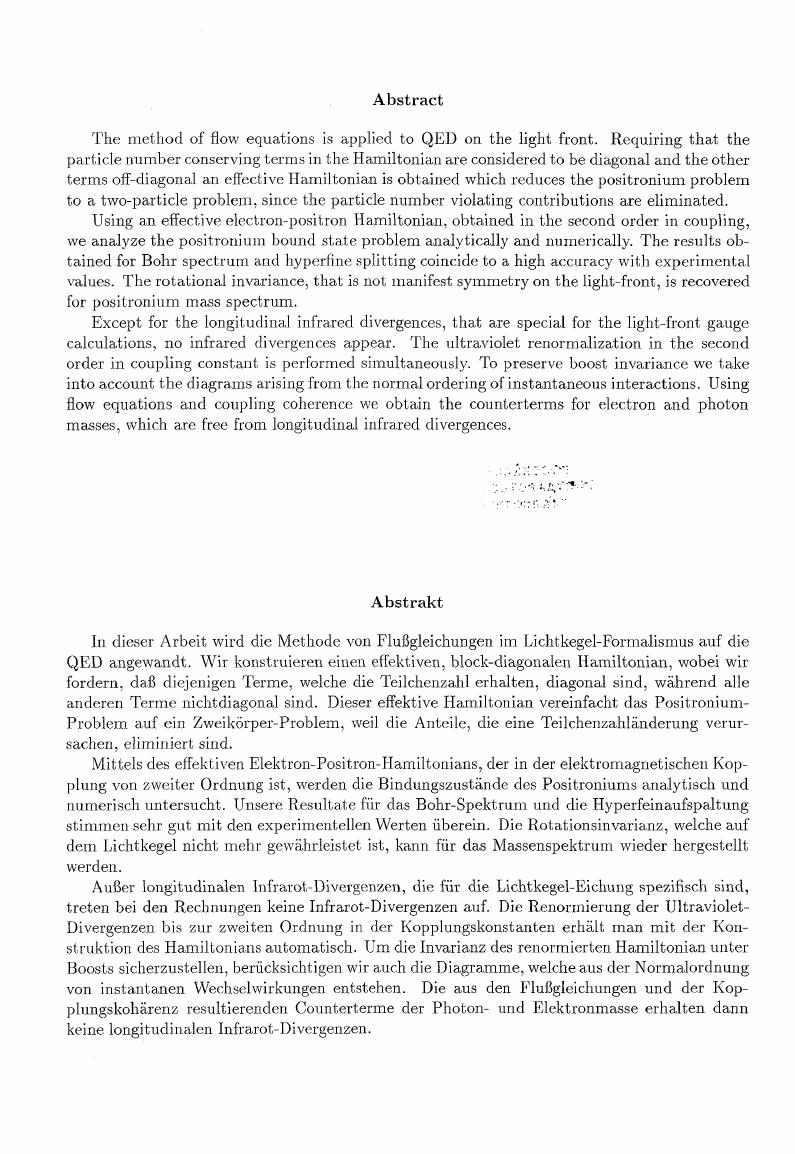Уравнение эволюции для квантовой электродинамики на световом фронте

- Автор:
Губанкова, Елена Львовна
- Шифр специальности:
01.04.02
- Научная степень:
Кандидатская
- Год защиты:
1998
- Место защиты:
Москва
- Количество страниц:
100 с.
Стоимость:
700 р.499 руб.
до окончания действия скидки
00
00
00
00
+
Наш сайт выгодно отличается тем что при покупке, кроме PDF версии Вы в подарок получаете работу преобразованную в WORD - документ и это предоставляет качественно другие возможности при работе с документом
Страницы оглавления работы


FLOW EQUATIONS FOR THE QUANTUM ELECTRODYNAMICS ON THE LIGHT-FRONT
Gutachter: Prof. Dr. Franz Wegner
Prof. Dr.Hans-Christian Pauli
Abstract
The method of flow equations is applied to QED on the light front. Requiring that the particle number conserving terms in the Hamiltonian are considered to be diagonal and the other terms off-diagonal an effective Hamiltonian is obtained which reduces the positronium problem to a two-particle problem., since the particle number violating contributions are eliminated.
Using an effective electron-positron Hamiltonian, obtained in the second order in coupling, we analyze the positronium bound state problem analytically and numerically. The results obtained for Bohr spectrum and hyperfme splitting coincide to a high accuracy with experimental values. The rotational invariance, that is not manifest symmetry on the light-front, is recovered for positronium mass spectrum.
Except for the longitudinal infrared divergences, that are special for the light-front gauge calculations, no infrared divergences appear. The ultraviolet renormalization in the second order in coupling constant is performed simultaneously. To preserve boost invariance we take into account the diagrams arising from the normal ordering of instantaneous interactions. Using flow equations and coupling coherence we obtain the counterterms for electron and photon masses, which are free from longitudinal infrared divergences.
Abstrakt
In dieser Arbeit wird die Methode von Flußgleichungen im Lichtkegel-Formalismus auf die QED angewandt. Wir konstruieren einen effektiven, block-diagonalen Ilamiltonian, wobei wir fordern, daß diejenigen Terme, welche die Teilchenzahl erhalten, diagonal sind, während alle anderen Terme nichtdiagonal sind. Dieser effektive Hamiltonian vereinfacht das Positronium-Problem auf ein Zweikörper-Problem, weil die Anteile, die eine Teilchenzahländerung verursachen, eliminiert sind.
Mittels des effektiven Elektron-Positron-Hamiltonians, der in der elektromagnetischen Kopplung von zweiter Ordnung ist, werden die Bindungszustände des Positroniums analytisch und numerisch untersucht. Unsere Resultate für das Bohr-Spektrum und die Hyperfeinaufspaltung stimmen sehr gut mit den experimentellen Werten überein. Die Rotationsinvarianz, welche auf dem Lichtkegel nicht mehr gewährleistet ist, kann für das Massenspektrum wieder hergestellt werden.
Außer longitudinalen Infrarot-Divergenzen, die für die Lichtkegel-Eichung spezifisch sind, treten bei den Rechnungen keine Infrarot-Divergenzen auf. Die Renormierung der Ultraviolet-Divergenzen bis zur zweiten Ordnung in der Kopplungskonstanten erhält man mit der Konstruktion des Hamiltonians automatisch. Um die Invarianz des renormierten Hamiltonian unter Boosts sicherzustellen, berücksichtigen wir auch die Diagramme, welche aus der Normalordnung von instantanen Wechselwirkungen entstehen. Die aus den Flußgleichungen und der Kopplungskohärenz resultierenden Counterterme der Photon- und Elektronmasse erhalten dann keine longitudinalen Infrarot-Divergenzen.
Contents
1 Introduction
2 Flow equations
2.1 Flow equations for Hamiltonian matrices
2.2 Similarity transformation
2.3 Flow equations for solid state physics
2.4 Flow equations in field theory
3 Light-front field theory
3.1 Introduction
3.2 Preceding work
3.2.1 Models and methods in the light-front field theory
3.2.2 Results for light front QED3+i
3.3 Canonical QED Hamiltonian
3.3.1 Canonical light-front QED3+1 Hamiltonian
3.3.2 QED Hamiltonian in second quantization
4 Hamiltonian bound state problem on the light-front
4.1 Introduction
4.2 Flow equations in the perturbative frame
4.3 Effective low-energy Hamiltonian
4.3.1 Effective electron-positron interaction
4.3.2 Positronium model (general computational strategy)
4.3.3 Effective, renormalized QED Hamiltonian
5 Positronium spectrum (analytically)
5.1 Bound state perturbative theory (BSPT)
5.2 Effective electron-positron interaction in light-front and instant frames
5.3 Positronium’s ground state spin splitting
6 Positronium spectrum (numerically)
6.1 Light-front bound state equation
6.2 Brodsky-Lepage prescription of the light-front dynamics: effective electron-positron
interaction
6.2.1 First and second order solutions of the flow equations
6.2.2 Effective electron-positron interaction
6.3 Mass spectrum and wave functions of positronium
Chapter 5 Positronium spectrum (analytically)
In this chapter we solve an effective eigenvalue equation for positronium, obtained in the previous chapter, analytically. We perform the bound state calculations perturbatively. The idea of calculations is the following. We split an effective Hamiltonian He into H° a part which is solved nonperturbatively, and SV, the difference between the original Hamiltonian and H° The effects of 8V are to be computed using bound state perturbation theory. The criteria for choosing His that it approximates the physics relevant for the given bound states (positronium in our case) as closely as possible. As a consequence, H'0' contributes the dominant term to the mass spectrum and the bound state perturbation theory converges with respect to SV/H° For QED, where the analytic answer is known, the leading order solution is simply given by a sum of kinetic terms and the Coulomb potential. This result arise straightforward from the form of the effective electron-positron Hamiltonian in the nonrelativistic limit. For more complicated theories as QCD the hint to choose H comes from phenomenological models.
In the next section we define explicitly bound state perturbation theory for positronium system. The calculation of Bohr spectrum and the ground state spin-splittings is given further. In analytical calculations of singlet-triplet spin-splitting we follow the work [39].
5.1 Bound state perturbative theory (BSPT)
First introduce instead of the light front parameterization fig.(3), used before for the singleparticle momenta, the instant form. We express the variable (x,k_l) in terms of the equal-time variable p = (pz, k±) as
+ (5-1)
2 y/p2 + m2
0* =P2z + «i (5-2)
and similarly for x' and p 2 as function of pz.
The Jacobian of this transformation, J(p), is
dx k]_ + m2
“ dpz ~ 2{f + m2)3/2 ' (
The instant form is used for practical purposes: it is simpler to recover the rotational symmetry there, the symmetry that is not manifest in the light-front frame.
We choose the leading order Hamiltonian operator for positronium
ff(°) = h + Vcoul , (5.4)
Рекомендуемые диссертации данного раздела
| Название работы | Автор | Дата защиты |
|---|---|---|
| Поляризационные характеристики атомных ансамблей при их когерентном возбуждении | Сытенко Наталья Викторовна | 2016 |
| Электрон-атомное рассеяние и радиационная рекомбинация в сильном лазерном поле | Желтухин, Александр Николаевич | 2012 |
| Статистическая механика классического релятивистского газа с учетом флуктуации давления | Кейта Ибраима | 2007 |